Stable Economic Equilibrium
VerifiedAdded on 2019/10/31
|9
|1378
|264
Essay
AI Summary
This essay examines the concept of stable economic equilibrium, focusing on whether the Australian economy exhibits this characteristic. It defines stable equilibrium in terms of market equilibrium and macroeconomic stability, illustrating the concept using supply and demand curves and aggregate demand and supply models. The essay analyzes Australia's economic stability using key macroeconomic indicators such as GDP growth and inflation rates, presenting data to support its claims. It also discusses the role of government intervention through automatic and discretionary stabilization instruments, such as tax policies and government spending, in maintaining economic stability. The conclusion summarizes the findings, highlighting that Australia's economy demonstrates stable equilibrium, although government intervention plays a crucial role in managing economic fluctuations.
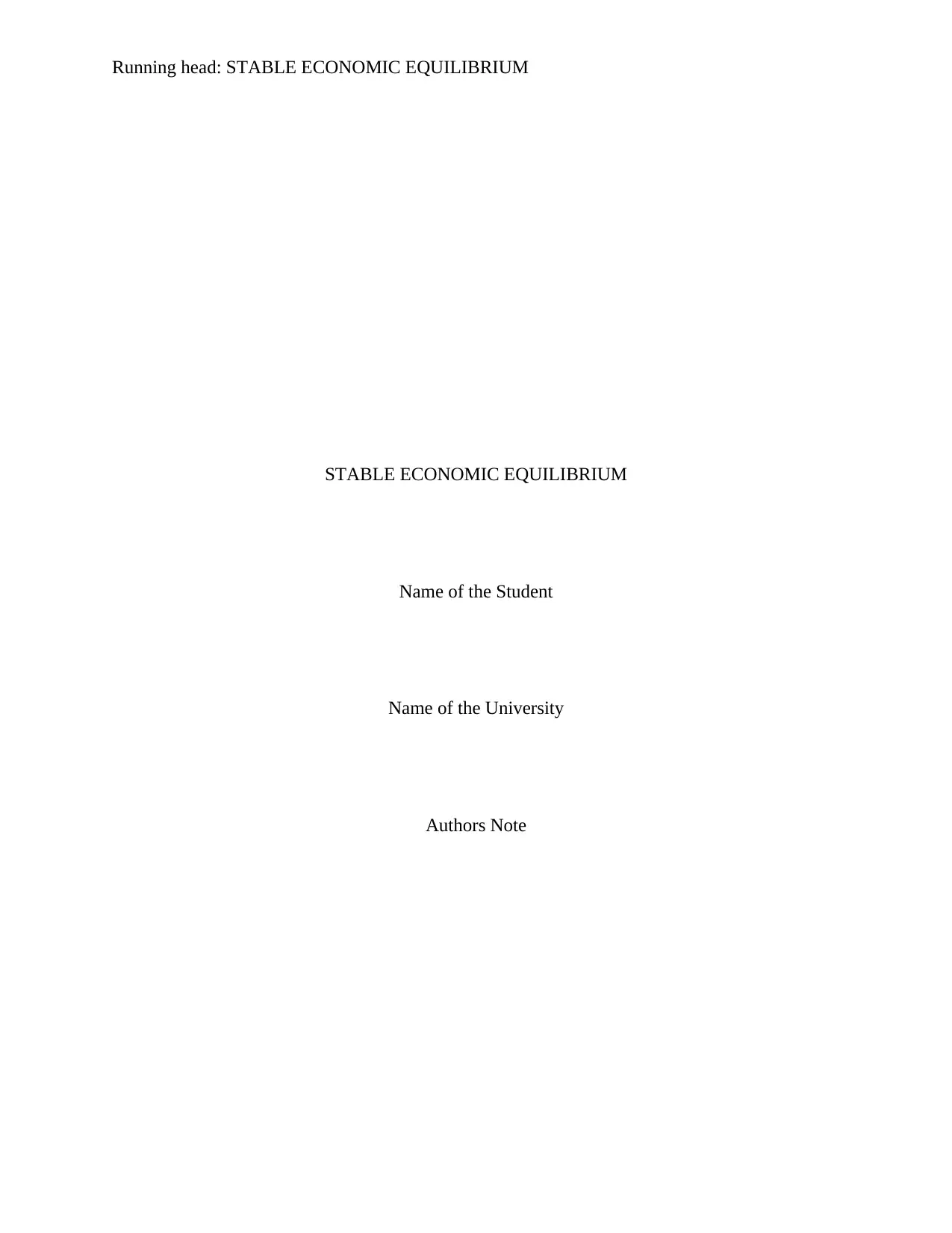
Running head: STABLE ECONOMIC EQUILIBRIUM
STABLE ECONOMIC EQUILIBRIUM
Name of the Student
Name of the University
Authors Note
STABLE ECONOMIC EQUILIBRIUM
Name of the Student
Name of the University
Authors Note
Paraphrase This Document
Need a fresh take? Get an instant paraphrase of this document with our AI Paraphraser
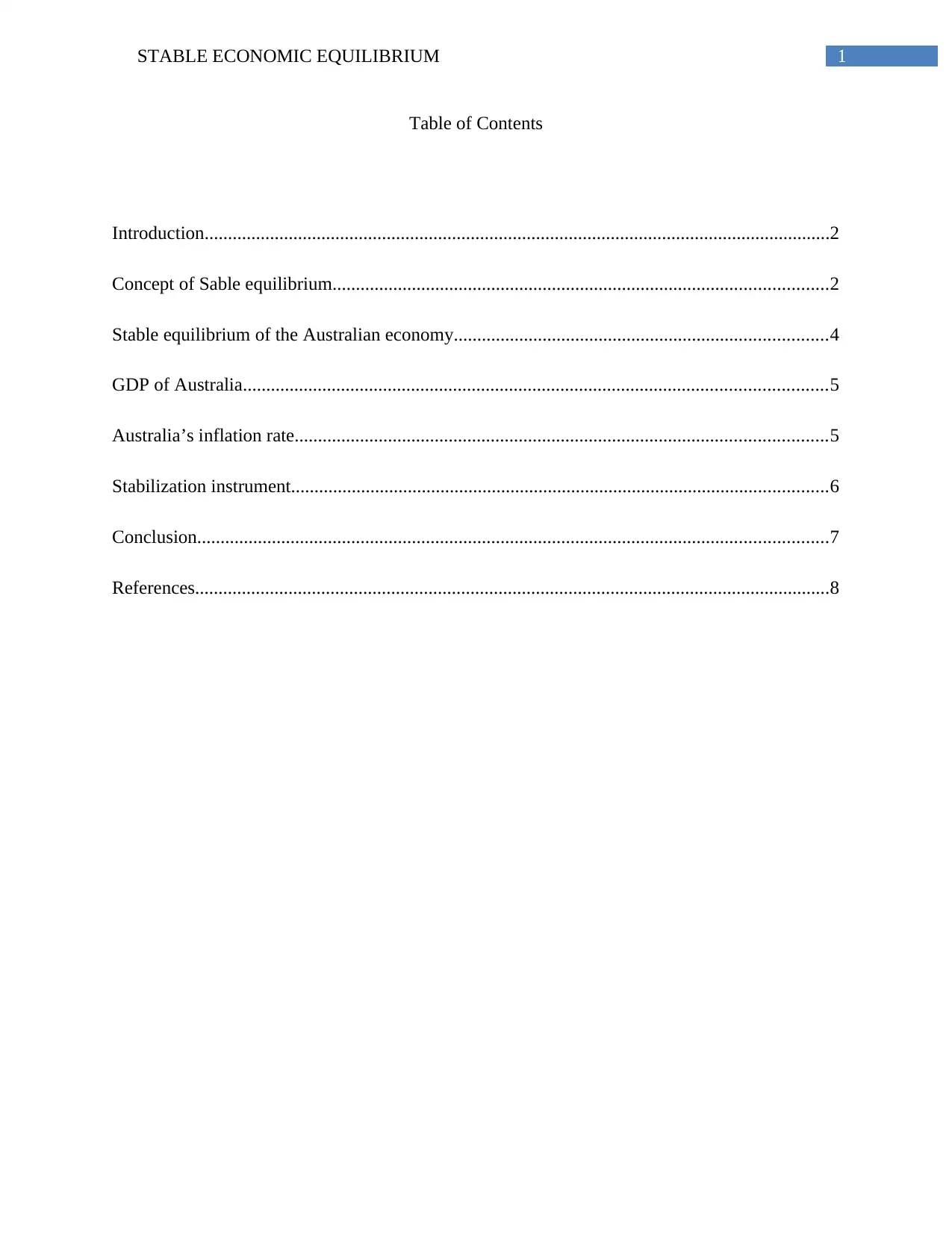
1STABLE ECONOMIC EQUILIBRIUM
Table of Contents
Introduction......................................................................................................................................2
Concept of Sable equilibrium..........................................................................................................2
Stable equilibrium of the Australian economy................................................................................4
GDP of Australia.............................................................................................................................5
Australia’s inflation rate..................................................................................................................5
Stabilization instrument...................................................................................................................6
Conclusion.......................................................................................................................................7
References........................................................................................................................................8
Table of Contents
Introduction......................................................................................................................................2
Concept of Sable equilibrium..........................................................................................................2
Stable equilibrium of the Australian economy................................................................................4
GDP of Australia.............................................................................................................................5
Australia’s inflation rate..................................................................................................................5
Stabilization instrument...................................................................................................................6
Conclusion.......................................................................................................................................7
References........................................................................................................................................8
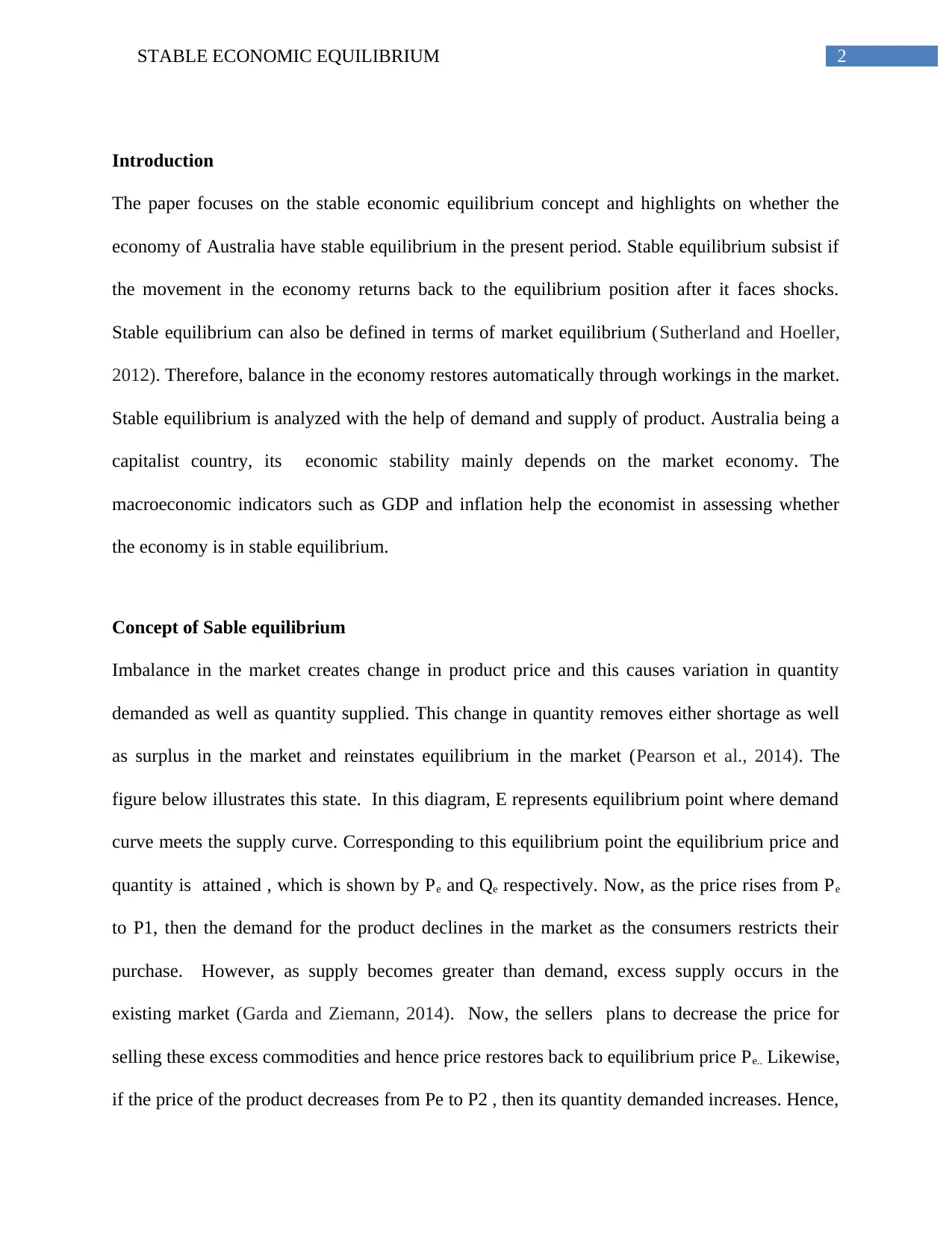
2STABLE ECONOMIC EQUILIBRIUM
Introduction
The paper focuses on the stable economic equilibrium concept and highlights on whether the
economy of Australia have stable equilibrium in the present period. Stable equilibrium subsist if
the movement in the economy returns back to the equilibrium position after it faces shocks.
Stable equilibrium can also be defined in terms of market equilibrium (Sutherland and Hoeller,
2012). Therefore, balance in the economy restores automatically through workings in the market.
Stable equilibrium is analyzed with the help of demand and supply of product. Australia being a
capitalist country, its economic stability mainly depends on the market economy. The
macroeconomic indicators such as GDP and inflation help the economist in assessing whether
the economy is in stable equilibrium.
Concept of Sable equilibrium
Imbalance in the market creates change in product price and this causes variation in quantity
demanded as well as quantity supplied. This change in quantity removes either shortage as well
as surplus in the market and reinstates equilibrium in the market (Pearson et al., 2014). The
figure below illustrates this state. In this diagram, E represents equilibrium point where demand
curve meets the supply curve. Corresponding to this equilibrium point the equilibrium price and
quantity is attained , which is shown by Pe and Qe respectively. Now, as the price rises from Pe
to P1, then the demand for the product declines in the market as the consumers restricts their
purchase. However, as supply becomes greater than demand, excess supply occurs in the
existing market (Garda and Ziemann, 2014). Now, the sellers plans to decrease the price for
selling these excess commodities and hence price restores back to equilibrium price Pe.. Likewise,
if the price of the product decreases from Pe to P2 , then its quantity demanded increases. Hence,
Introduction
The paper focuses on the stable economic equilibrium concept and highlights on whether the
economy of Australia have stable equilibrium in the present period. Stable equilibrium subsist if
the movement in the economy returns back to the equilibrium position after it faces shocks.
Stable equilibrium can also be defined in terms of market equilibrium (Sutherland and Hoeller,
2012). Therefore, balance in the economy restores automatically through workings in the market.
Stable equilibrium is analyzed with the help of demand and supply of product. Australia being a
capitalist country, its economic stability mainly depends on the market economy. The
macroeconomic indicators such as GDP and inflation help the economist in assessing whether
the economy is in stable equilibrium.
Concept of Sable equilibrium
Imbalance in the market creates change in product price and this causes variation in quantity
demanded as well as quantity supplied. This change in quantity removes either shortage as well
as surplus in the market and reinstates equilibrium in the market (Pearson et al., 2014). The
figure below illustrates this state. In this diagram, E represents equilibrium point where demand
curve meets the supply curve. Corresponding to this equilibrium point the equilibrium price and
quantity is attained , which is shown by Pe and Qe respectively. Now, as the price rises from Pe
to P1, then the demand for the product declines in the market as the consumers restricts their
purchase. However, as supply becomes greater than demand, excess supply occurs in the
existing market (Garda and Ziemann, 2014). Now, the sellers plans to decrease the price for
selling these excess commodities and hence price restores back to equilibrium price Pe.. Likewise,
if the price of the product decreases from Pe to P2 , then its quantity demanded increases. Hence,
⊘ This is a preview!⊘
Do you want full access?
Subscribe today to unlock all pages.

Trusted by 1+ million students worldwide
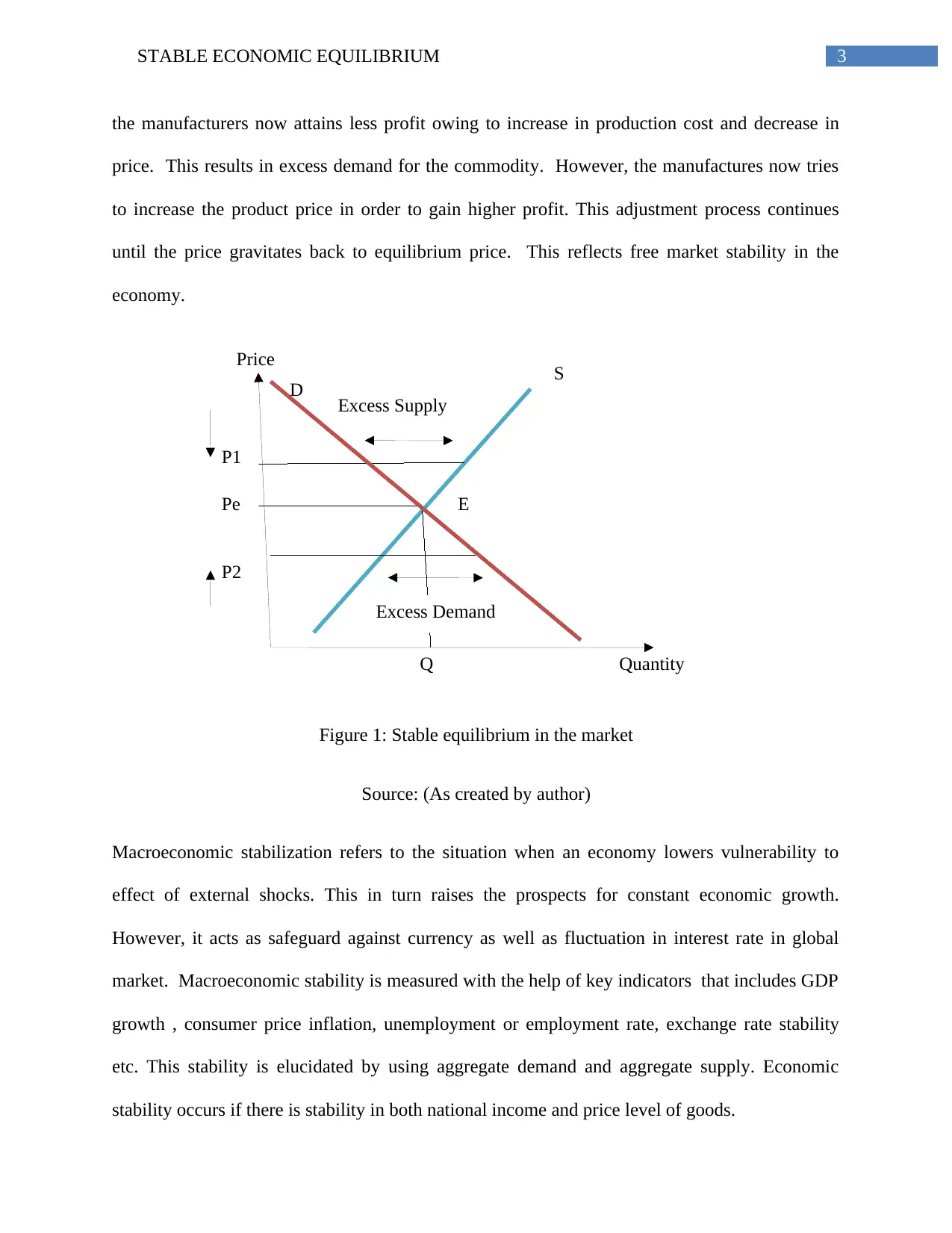
3STABLE ECONOMIC EQUILIBRIUM
S
D
E
Quantity
Price
Pe
P1
P2
Q
Excess Supply
Excess Demand
the manufacturers now attains less profit owing to increase in production cost and decrease in
price. This results in excess demand for the commodity. However, the manufactures now tries
to increase the product price in order to gain higher profit. This adjustment process continues
until the price gravitates back to equilibrium price. This reflects free market stability in the
economy.
Figure 1: Stable equilibrium in the market
Source: (As created by author)
Macroeconomic stabilization refers to the situation when an economy lowers vulnerability to
effect of external shocks. This in turn raises the prospects for constant economic growth.
However, it acts as safeguard against currency as well as fluctuation in interest rate in global
market. Macroeconomic stability is measured with the help of key indicators that includes GDP
growth , consumer price inflation, unemployment or employment rate, exchange rate stability
etc. This stability is elucidated by using aggregate demand and aggregate supply. Economic
stability occurs if there is stability in both national income and price level of goods.
S
D
E
Quantity
Price
Pe
P1
P2
Q
Excess Supply
Excess Demand
the manufacturers now attains less profit owing to increase in production cost and decrease in
price. This results in excess demand for the commodity. However, the manufactures now tries
to increase the product price in order to gain higher profit. This adjustment process continues
until the price gravitates back to equilibrium price. This reflects free market stability in the
economy.
Figure 1: Stable equilibrium in the market
Source: (As created by author)
Macroeconomic stabilization refers to the situation when an economy lowers vulnerability to
effect of external shocks. This in turn raises the prospects for constant economic growth.
However, it acts as safeguard against currency as well as fluctuation in interest rate in global
market. Macroeconomic stability is measured with the help of key indicators that includes GDP
growth , consumer price inflation, unemployment or employment rate, exchange rate stability
etc. This stability is elucidated by using aggregate demand and aggregate supply. Economic
stability occurs if there is stability in both national income and price level of goods.
Paraphrase This Document
Need a fresh take? Get an instant paraphrase of this document with our AI Paraphraser
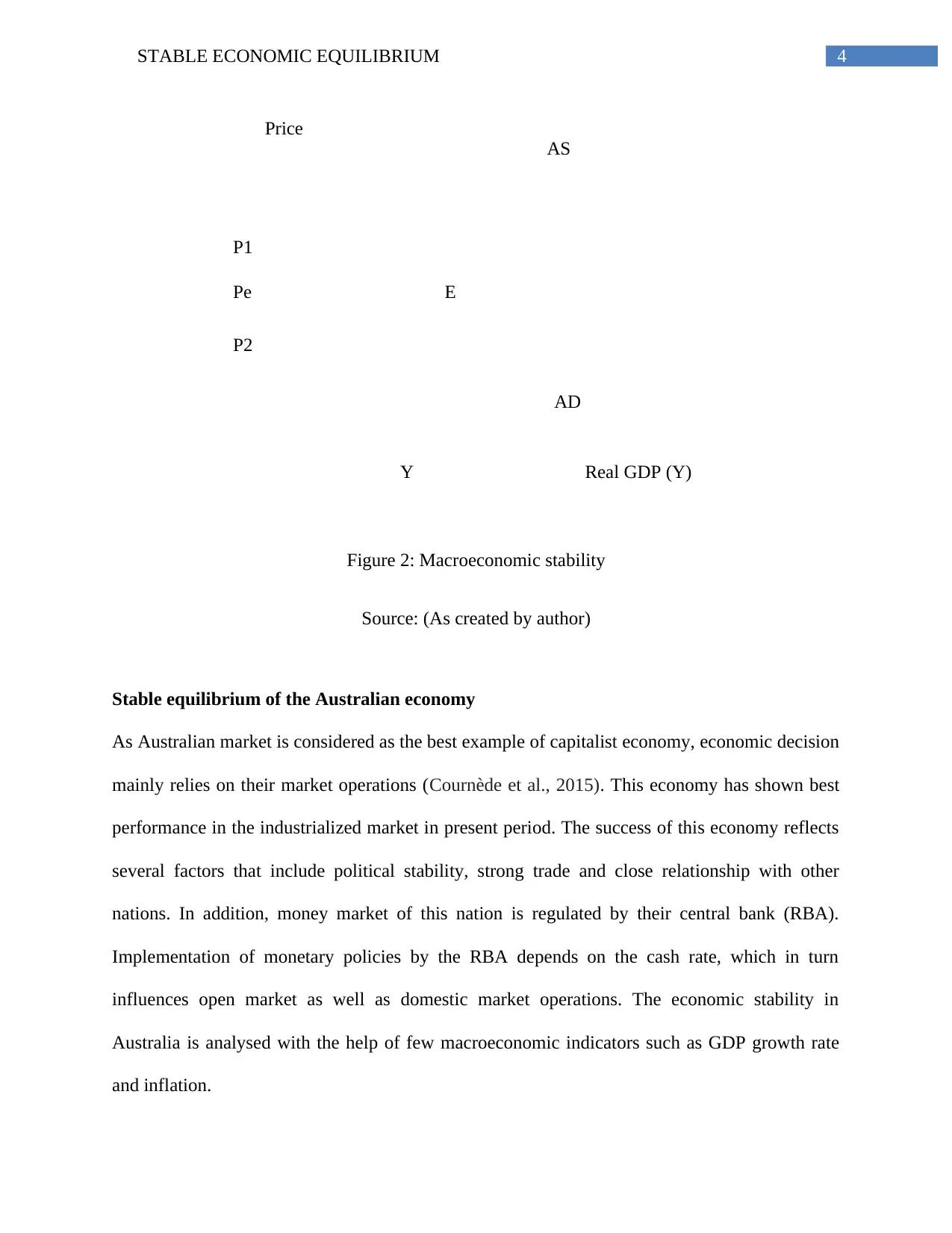
4STABLE ECONOMIC EQUILIBRIUM
AS
AD
Price
Real GDP (Y)
Pe
P2
P1
Y
E
Figure 2: Macroeconomic stability
Source: (As created by author)
Stable equilibrium of the Australian economy
As Australian market is considered as the best example of capitalist economy, economic decision
mainly relies on their market operations (Cournède et al., 2015). This economy has shown best
performance in the industrialized market in present period. The success of this economy reflects
several factors that include political stability, strong trade and close relationship with other
nations. In addition, money market of this nation is regulated by their central bank (RBA).
Implementation of monetary policies by the RBA depends on the cash rate, which in turn
influences open market as well as domestic market operations. The economic stability in
Australia is analysed with the help of few macroeconomic indicators such as GDP growth rate
and inflation.
AS
AD
Price
Real GDP (Y)
Pe
P2
P1
Y
E
Figure 2: Macroeconomic stability
Source: (As created by author)
Stable equilibrium of the Australian economy
As Australian market is considered as the best example of capitalist economy, economic decision
mainly relies on their market operations (Cournède et al., 2015). This economy has shown best
performance in the industrialized market in present period. The success of this economy reflects
several factors that include political stability, strong trade and close relationship with other
nations. In addition, money market of this nation is regulated by their central bank (RBA).
Implementation of monetary policies by the RBA depends on the cash rate, which in turn
influences open market as well as domestic market operations. The economic stability in
Australia is analysed with the help of few macroeconomic indicators such as GDP growth rate
and inflation.
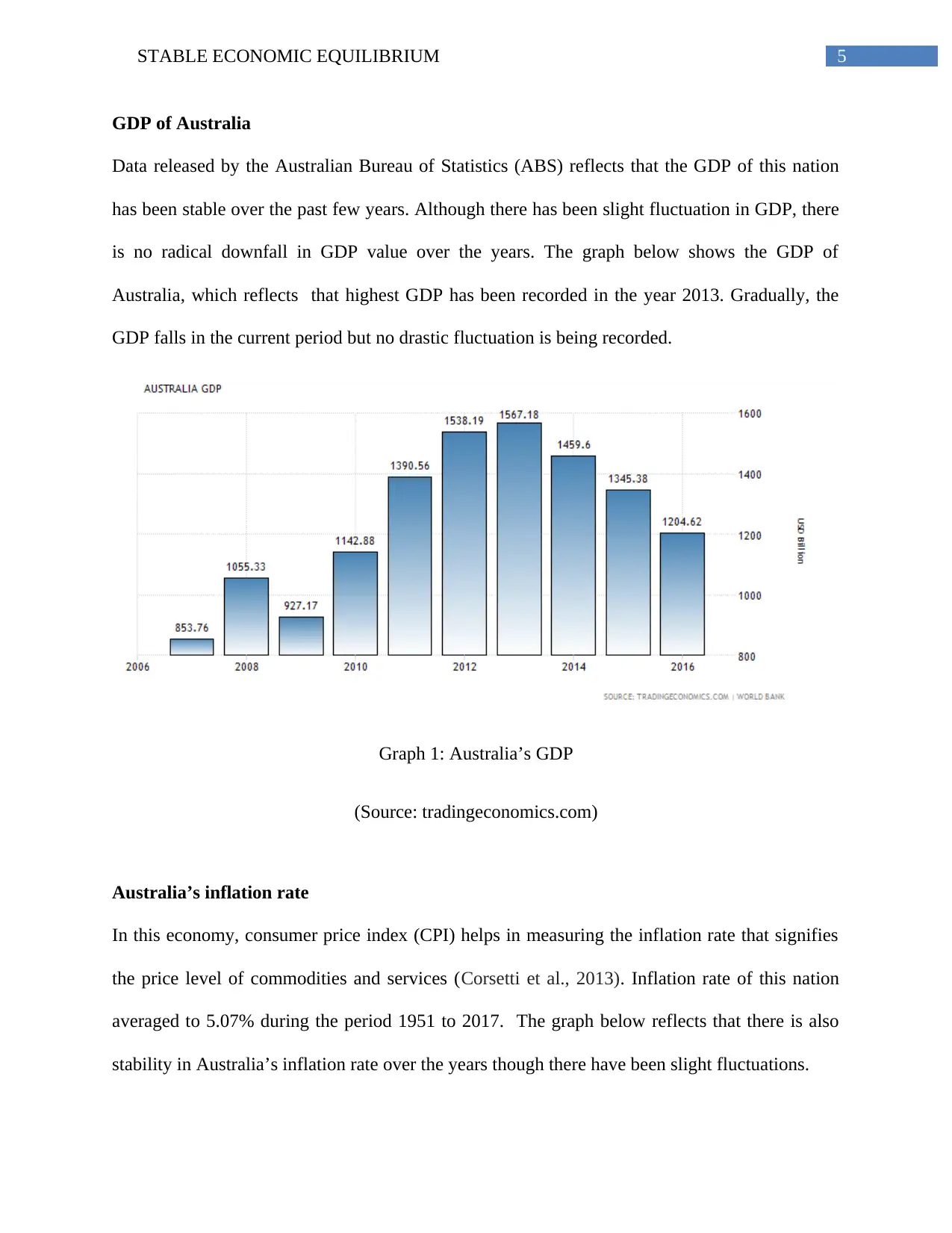
5STABLE ECONOMIC EQUILIBRIUM
GDP of Australia
Data released by the Australian Bureau of Statistics (ABS) reflects that the GDP of this nation
has been stable over the past few years. Although there has been slight fluctuation in GDP, there
is no radical downfall in GDP value over the years. The graph below shows the GDP of
Australia, which reflects that highest GDP has been recorded in the year 2013. Gradually, the
GDP falls in the current period but no drastic fluctuation is being recorded.
Graph 1: Australia’s GDP
(Source: tradingeconomics.com)
Australia’s inflation rate
In this economy, consumer price index (CPI) helps in measuring the inflation rate that signifies
the price level of commodities and services (Corsetti et al., 2013). Inflation rate of this nation
averaged to 5.07% during the period 1951 to 2017. The graph below reflects that there is also
stability in Australia’s inflation rate over the years though there have been slight fluctuations.
GDP of Australia
Data released by the Australian Bureau of Statistics (ABS) reflects that the GDP of this nation
has been stable over the past few years. Although there has been slight fluctuation in GDP, there
is no radical downfall in GDP value over the years. The graph below shows the GDP of
Australia, which reflects that highest GDP has been recorded in the year 2013. Gradually, the
GDP falls in the current period but no drastic fluctuation is being recorded.
Graph 1: Australia’s GDP
(Source: tradingeconomics.com)
Australia’s inflation rate
In this economy, consumer price index (CPI) helps in measuring the inflation rate that signifies
the price level of commodities and services (Corsetti et al., 2013). Inflation rate of this nation
averaged to 5.07% during the period 1951 to 2017. The graph below reflects that there is also
stability in Australia’s inflation rate over the years though there have been slight fluctuations.
⊘ This is a preview!⊘
Do you want full access?
Subscribe today to unlock all pages.

Trusted by 1+ million students worldwide
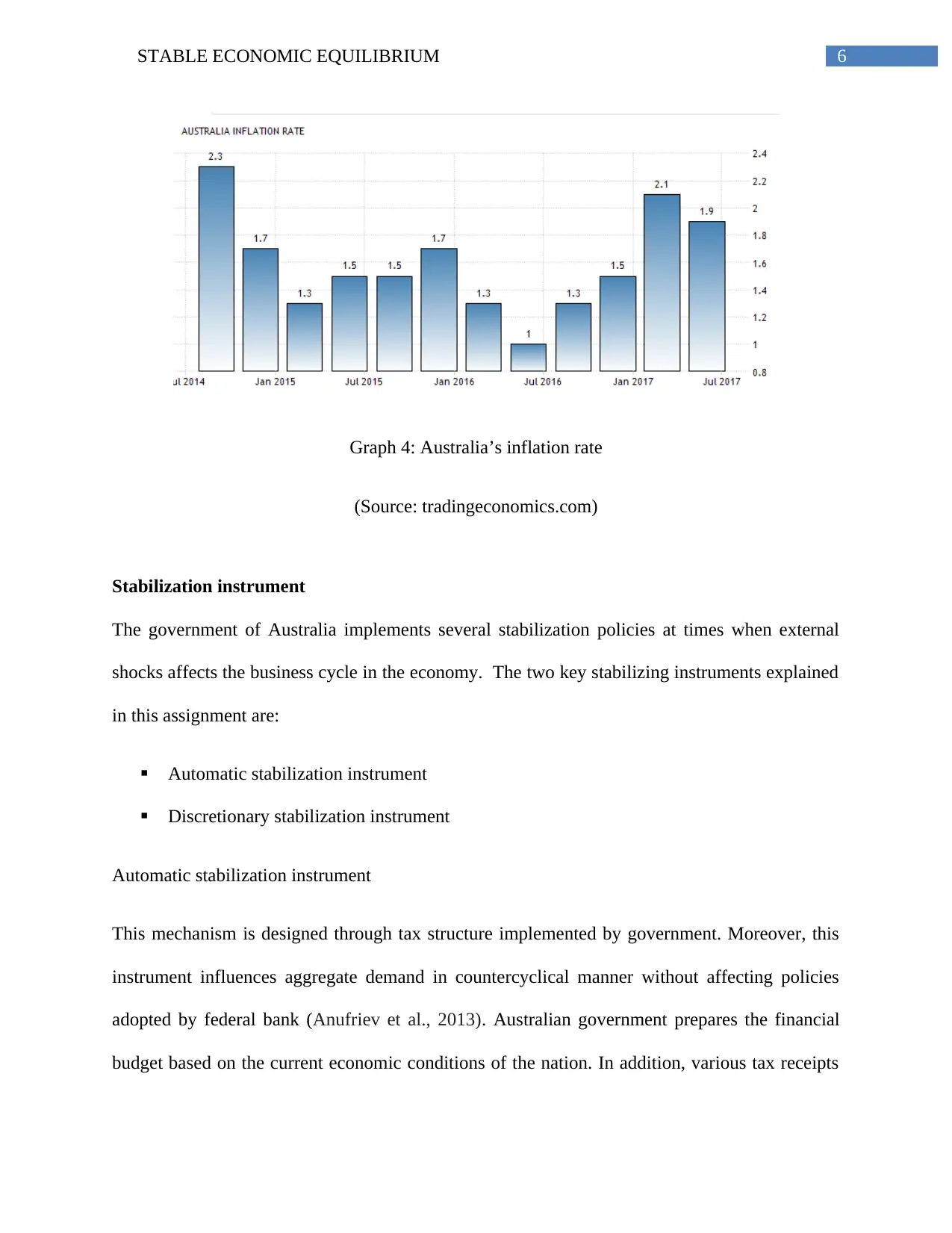
6STABLE ECONOMIC EQUILIBRIUM
Graph 4: Australia’s inflation rate
(Source: tradingeconomics.com)
Stabilization instrument
The government of Australia implements several stabilization policies at times when external
shocks affects the business cycle in the economy. The two key stabilizing instruments explained
in this assignment are:
Automatic stabilization instrument
Discretionary stabilization instrument
Automatic stabilization instrument
This mechanism is designed through tax structure implemented by government. Moreover, this
instrument influences aggregate demand in countercyclical manner without affecting policies
adopted by federal bank (Anufriev et al., 2013). Australian government prepares the financial
budget based on the current economic conditions of the nation. In addition, various tax receipts
Graph 4: Australia’s inflation rate
(Source: tradingeconomics.com)
Stabilization instrument
The government of Australia implements several stabilization policies at times when external
shocks affects the business cycle in the economy. The two key stabilizing instruments explained
in this assignment are:
Automatic stabilization instrument
Discretionary stabilization instrument
Automatic stabilization instrument
This mechanism is designed through tax structure implemented by government. Moreover, this
instrument influences aggregate demand in countercyclical manner without affecting policies
adopted by federal bank (Anufriev et al., 2013). Australian government prepares the financial
budget based on the current economic conditions of the nation. In addition, various tax receipts
Paraphrase This Document
Need a fresh take? Get an instant paraphrase of this document with our AI Paraphraser
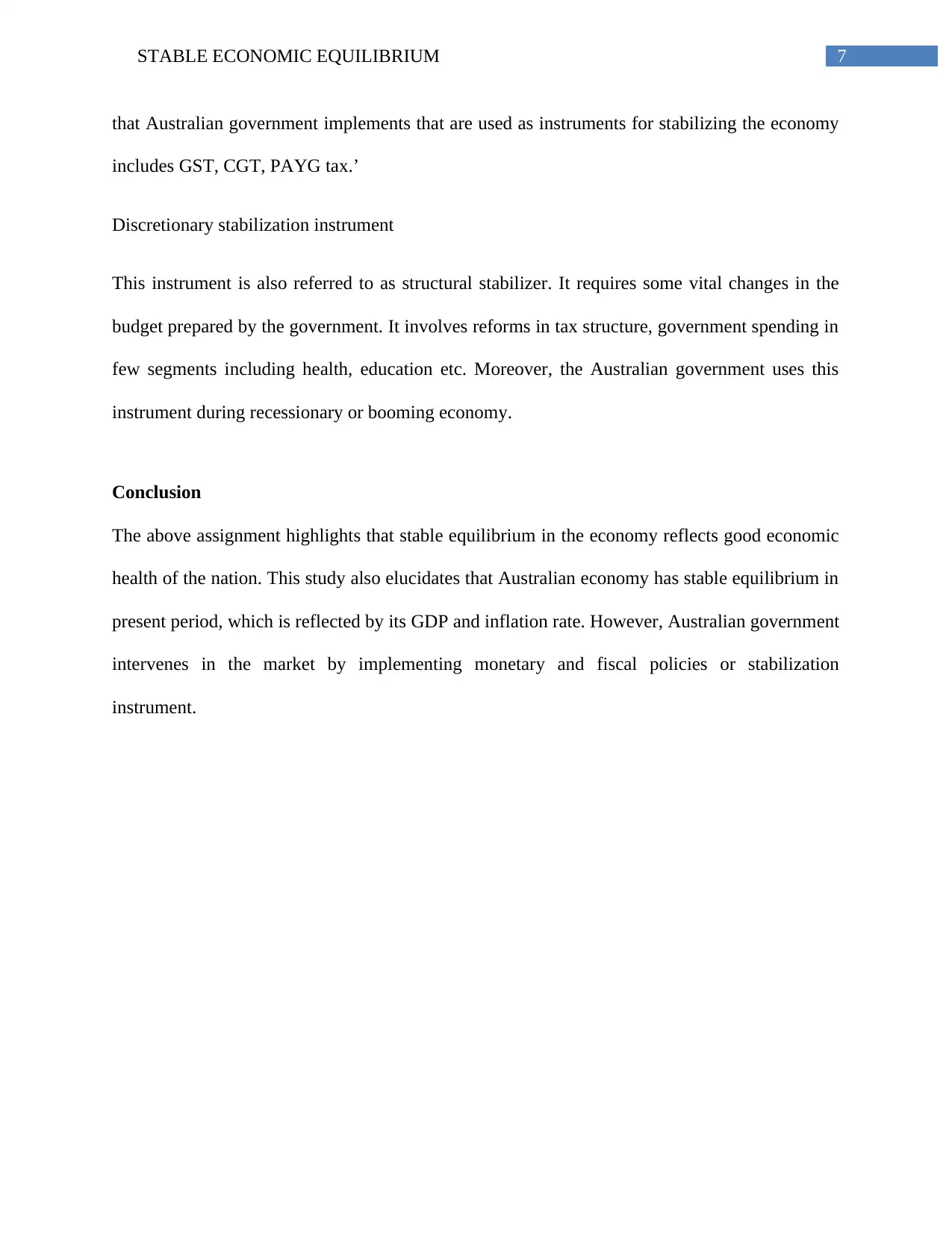
7STABLE ECONOMIC EQUILIBRIUM
that Australian government implements that are used as instruments for stabilizing the economy
includes GST, CGT, PAYG tax.’
Discretionary stabilization instrument
This instrument is also referred to as structural stabilizer. It requires some vital changes in the
budget prepared by the government. It involves reforms in tax structure, government spending in
few segments including health, education etc. Moreover, the Australian government uses this
instrument during recessionary or booming economy.
Conclusion
The above assignment highlights that stable equilibrium in the economy reflects good economic
health of the nation. This study also elucidates that Australian economy has stable equilibrium in
present period, which is reflected by its GDP and inflation rate. However, Australian government
intervenes in the market by implementing monetary and fiscal policies or stabilization
instrument.
that Australian government implements that are used as instruments for stabilizing the economy
includes GST, CGT, PAYG tax.’
Discretionary stabilization instrument
This instrument is also referred to as structural stabilizer. It requires some vital changes in the
budget prepared by the government. It involves reforms in tax structure, government spending in
few segments including health, education etc. Moreover, the Australian government uses this
instrument during recessionary or booming economy.
Conclusion
The above assignment highlights that stable equilibrium in the economy reflects good economic
health of the nation. This study also elucidates that Australian economy has stable equilibrium in
present period, which is reflected by its GDP and inflation rate. However, Australian government
intervenes in the market by implementing monetary and fiscal policies or stabilization
instrument.
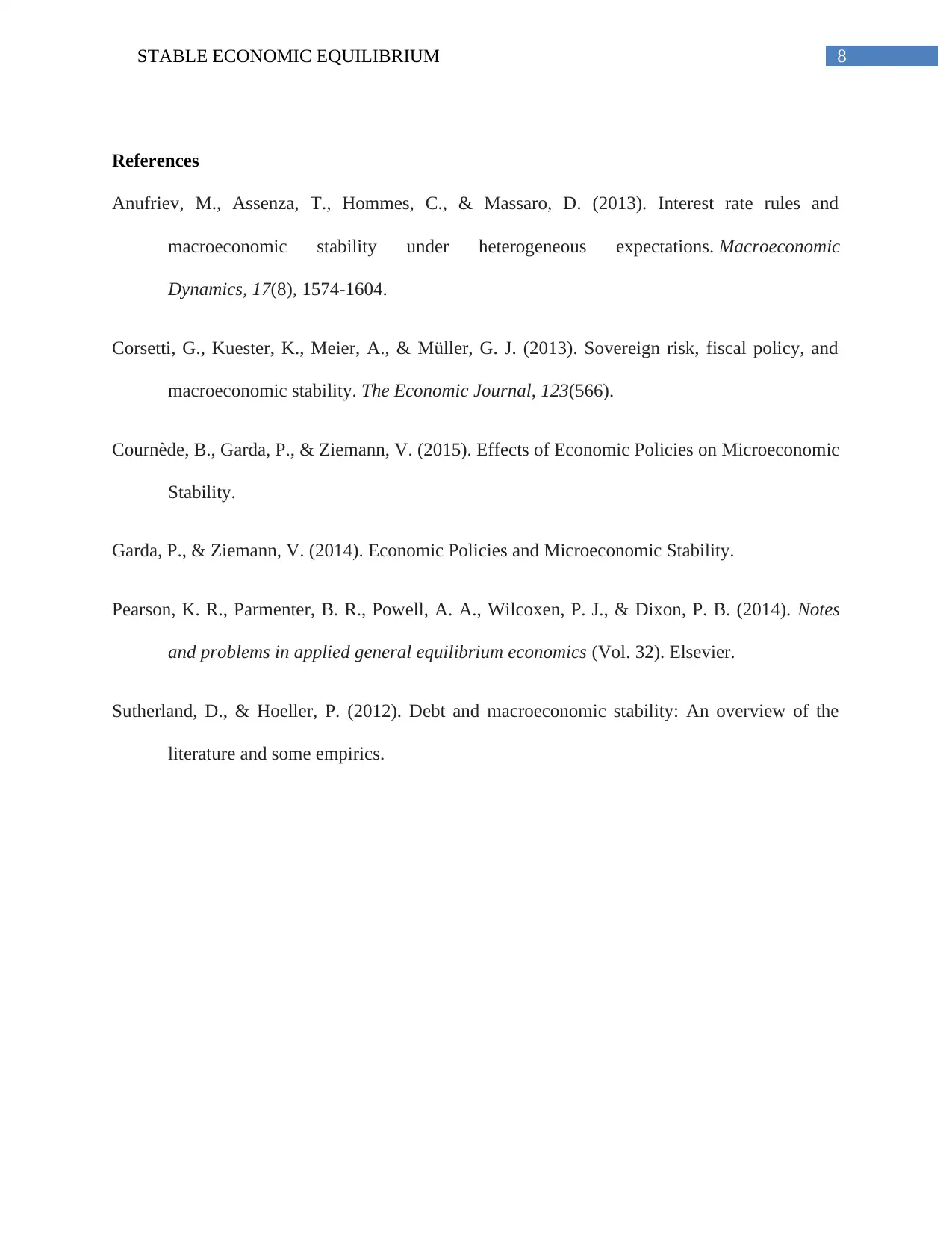
8STABLE ECONOMIC EQUILIBRIUM
References
Anufriev, M., Assenza, T., Hommes, C., & Massaro, D. (2013). Interest rate rules and
macroeconomic stability under heterogeneous expectations. Macroeconomic
Dynamics, 17(8), 1574-1604.
Corsetti, G., Kuester, K., Meier, A., & Müller, G. J. (2013). Sovereign risk, fiscal policy, and
macroeconomic stability. The Economic Journal, 123(566).
Cournède, B., Garda, P., & Ziemann, V. (2015). Effects of Economic Policies on Microeconomic
Stability.
Garda, P., & Ziemann, V. (2014). Economic Policies and Microeconomic Stability.
Pearson, K. R., Parmenter, B. R., Powell, A. A., Wilcoxen, P. J., & Dixon, P. B. (2014). Notes
and problems in applied general equilibrium economics (Vol. 32). Elsevier.
Sutherland, D., & Hoeller, P. (2012). Debt and macroeconomic stability: An overview of the
literature and some empirics.
References
Anufriev, M., Assenza, T., Hommes, C., & Massaro, D. (2013). Interest rate rules and
macroeconomic stability under heterogeneous expectations. Macroeconomic
Dynamics, 17(8), 1574-1604.
Corsetti, G., Kuester, K., Meier, A., & Müller, G. J. (2013). Sovereign risk, fiscal policy, and
macroeconomic stability. The Economic Journal, 123(566).
Cournède, B., Garda, P., & Ziemann, V. (2015). Effects of Economic Policies on Microeconomic
Stability.
Garda, P., & Ziemann, V. (2014). Economic Policies and Microeconomic Stability.
Pearson, K. R., Parmenter, B. R., Powell, A. A., Wilcoxen, P. J., & Dixon, P. B. (2014). Notes
and problems in applied general equilibrium economics (Vol. 32). Elsevier.
Sutherland, D., & Hoeller, P. (2012). Debt and macroeconomic stability: An overview of the
literature and some empirics.
⊘ This is a preview!⊘
Do you want full access?
Subscribe today to unlock all pages.

Trusted by 1+ million students worldwide
1 out of 9
Related Documents
Your All-in-One AI-Powered Toolkit for Academic Success.
+13062052269
info@desklib.com
Available 24*7 on WhatsApp / Email
![[object Object]](/_next/static/media/star-bottom.7253800d.svg)
Unlock your academic potential
Copyright © 2020–2025 A2Z Services. All Rights Reserved. Developed and managed by ZUCOL.





